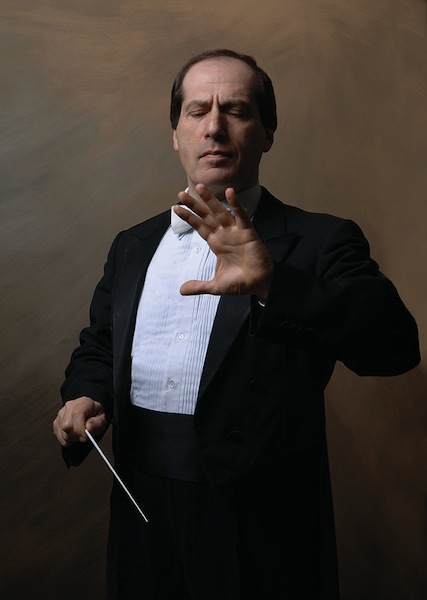Moscow State Symphony brings muscle to choice program at Kravis Center

Pavel Kogan conducted the Moscow State Symphony Orchestra Wednesday afternoon at the Kravis Center in West Palm Beach.
Russian orchestras usually present formulaic programs when touring, especially in South Florida. An overture or ballet suite will be followed by a Tchaikovsky or Rachmaninoff concerto as a showcase for the soloist. Then the performance will conclude with one of Tchaikovsky’s last three symphonies or Rachmaninoff’s 2nd or Shostakovich’s 5th Symphony—flashy scores guaranteed to generate cheers.
The Moscow State Symphony took a refreshingly different approach for its Regional Arts series concert Wednesday afternoon at the Kravis Center in West Palm Beach. The blockbuster concerto was indeed played but it was surrounded by an early Rachmaninoff curio and a grandly romantic symphony by the young Alexander Scriabin.
Subtlety is not this orchestra’s strong point. It makes a big corporate sound and seldom plays a true pianissimo. While not quite in the top tier of Russian ensembles, it is several levels above many of the uneven Russian orchestras that have played South Florida in recent seasons.
The strings produce a sizable, dark tone. Winds display that veiled sonority that is typical in many Russian and Eastern European orchestras but the flute and clarinet principals are first rate. The brass are especially well blended, bereft of the raucousness that characterized many Soviet era orchestras.
Pavel Kogan, son of the famed violinist Leonid Kogan, has been the orchestra’s music director since 1989 and he is the perfect conductor for this group. Leading with an unusually long baton, Kogan is a fiery presence on the podium. He brings out this orchestra’s gleam and tonal power for all it is worth.
The program opened with The Rock, a brief tone poem by the twenty-year-old Rachmaninoff. The nine-minute score is dedicated to Rimsky-Korsakov (one of Rachmaninoff’s teachers) and much of the work sounds like rejected outtakes from that composer’s Scheherazade or Antar Symphony. Kogan managed to bring a degree of coherence to a rather episodic essay by a composer who has not yet found his voice.
Tchaikovsky’s Piano Concerto No. 1 in B-flat minor served as a vehicle for Dmitry Masleev, top prize winner of the Tchaikovsky Competition in 2015. This was no ordinary traversal of an oft-programmed warhorse. Playing at competition standard, Masleev charged through the first movement, displaying a steel-fingered monster technique. His playing was not merely a metronomic display at top volume. There was a visceral charge to his performance that made one sit up and listen. He brought Lisztian fury to the first movement cadenza and the barn-burning Allegro con fuoco finale was fleet indeed.
Yet Masleev could also produce finely shaded soft tones and he made the melodic lines of the Andantino semplice really sing. Kogan’s clear beat kept the ensemble in pace with Masleev, which was no small accomplishment, and his detailing of the wind lines was especially strong.
Masleev had the usually unresponsive Kravis matinee audience on their feet cheering and he responded with a transcription of the “Elegy” from Shostakovich’s Ballet Suite No. 3 as an encore. Playing with surprising delicacy, he beautifully dovetailed the haunting melody in the right hand with Chopinesque filigree in the left. Definitely an über virtuoso, Masleev clearly has many facets and it will be interesting to hear him in less flamboyant works.
Scriabin was one of music’s most original creative artists but his Symphony No. 2 in C minor predates his experiments with atonality, mysticism and tonal synesthesia. The five movement, 47-minute work owes much to the symphonic tradition of Tchaikovsky. Yet an original voice lurks beneath the thick string textures and brass chorales. There are moments when overt bombast holds sway but there is much inspired melodic writing and superb orchestration in this rarely played work which is clearly superior to the symphonies of Glazunov or Glière which sometimes find their way onto orchestral programs.
The richly burnished tone of Evgeny Solovey’s clarinet captured the melancholy aura of the initial Andante. In the second movement Allegro, Kogan marshaled his forces to pile one climax upon another. The shimmer of Aleey Mazur’s flute against enveloping strings melded into a full-scale romantic melody right out of Hollywood in the best sense during the third movement. Kogan whipped up a pounding storm in the Tempestoso. The brass fanfare that opens the final Maestoso is a transformation of the moody theme that opened the symphony. Kogan’s full-throttle reading avoided vulgarity while highlighting his ensemble’s corporate impact and color.
For encores Kogan offered an unabashedly brash version of the Waltz from the Masquerade Suite by Khachaturian that did not attempt elegance where there was none and a witty, mock big-band romp through Shostakovich’s Tahiti Trot (after Vincent Youmans’ “Tea for Two”).
The Regional Arts Concert Series continues with pianist Vadym Kholodenko playing Tchaikovsky’s Sonata in G Major and Theme and Variations in F minor, and Scriabin’s Two Poèmes, and Sonatas Nos. 4 and 5 December 4 at 2 p.m. at the Kravis Center in West Palm Beach. kravis.org
Posted in Performances
Leave a Comment
Thu Nov 16, 2017
at 11:50 am
No Comments
